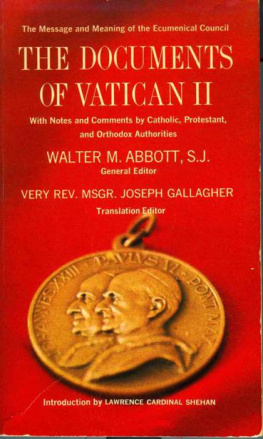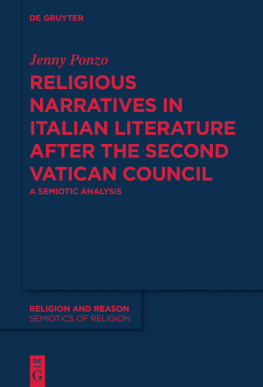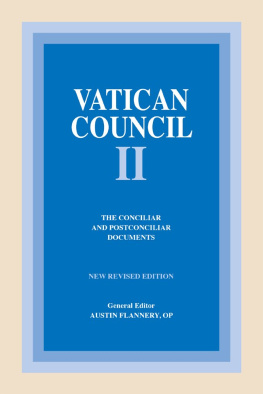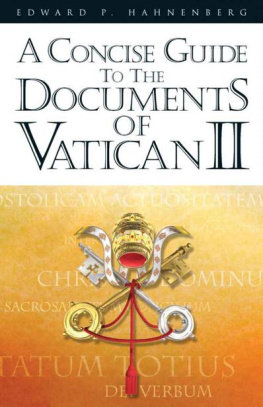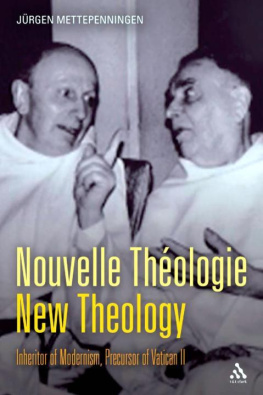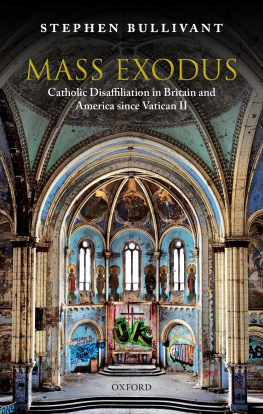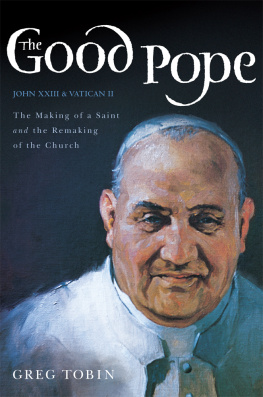THE DOCUMENTS OF VATICAN II
ALL SIXTEEN OFFICIAL TEXTS PROMULGATED
BY THE ECUMENICAL COUNCIL
1963-1965
TRANSLATED FROM THE LATIN
THE DOCUMENTS
OF VATICAN II
In a New and Definitive Translation
With Commentaries and Notes
By Catholic, Protestant and Orthodox,
Authorities
WALTER M. ABBOTT, S.J.
General Editor
Introduction by Lawrence Cardinal Shehan
Translations Directed by Joseph Gallagher
Copyright 1966 by The America Press
All rights reserved.
PREFACE TO THE TRANSLATION
What the Second Vatican Council said is what it said in its official Latin texts. Exclusive of 992 footnotes of varying length, the sixteen promulgated texts run to approximately 103,014 words.
(1. Dogmatic Constitution on the Church: 16,200 words;
2. Dogmatic Constitution on Divine Revelation: 2,996 words;
3. Constitution on the Sacred Liturgy: 7,806 words;
4. Pastoral Constitution on the Church in the Modern World: 23,335 words;
5. Decree on the Instruments of Social Communication: 2,225 words;
6. Decree on Ecumenism: 4,790 words;
7. Decree on Eastern Catholic Churches: 1,806 words;
8. Decree on the Bishops Pastoral Office in the Church: 5,982 words;
9. Decree on Priestly Formation: 2,987 words;
10. Decree on the Appropriate Renewal of the Religious Life: 3,189 words;
11. Decree on the Apostolate of the Laity: 7,016 words;
12. Decree on the Ministry and Life of Priests: 7,896 words;
13. Decree on the Churchs Missionary Activity: 9,870 words;
14. Declaration on Christian Education: 2,604 words;
15. Declaration on the Relationship of the Church to Non-Christian Religions: 1,117 words;
16. Declaration on Religious Freedom: 3,195 words;)
There are three main sources of these Latin texts: 1) the final versions distributed at the Council usually just before the last vote on a text and the actual promulgation of it by the Holy Father; 2) the Vatican newspaper, LOsservatore Romano , which printed the full Latin texts, one at a time, shortly after each one was promulgated; 3) the official Vatican periodical, Acta Apostolicae Sedis . So far only the first five Council documents have appeared in the Acta .
The translations in this volume are based on the Latin texts. In the case of the documents promulgated at the final Council session, slight differences exist between available Latin texts. Future editions of this volume will take advantage of whatever light is thrown on these discrepancies by the eventual appearance of the texts in the Acta . Where these differences have been caught they are noted in the present volume.
There are as yet no official English translations of these Council documents. A few translations, however, have been produced by highly knowledgeable and reliable persons. For the most part, there has not been sufficient time for production of truly authenticated translations, which would require, among other things, officially authorized translators with an intimate knowledge of the meetings held by the commissions that helped to produce each document. The notes of these meetings remain unpublished.
A translation could be technically accurate and yet fail to be intelligible and readable from the point of view of the general public. Such would surely be the case if the very long, involved sentences and paragraphs of the original were not broken into digestible portions. For example, one sentence in the text on the priestly ministry runs to 68 words; a paragraph in the document on the Church contains 276 words. At the same time, some Council paragraphs are only a few words long. As a general rule, the translations in this volume start a new paragraph wherever the original does, but they often start one where the original does not.
Every word in these translations was chosen in the light of their purpose: to provide the average American reader with as clear, accurate, and readable a rendering of the original documents as the subject matter, the available time, and resources of information would permit.
At times the original Latin deliberately treats a subject in an incomplete, indirect, or highly technical manner. In such cases the translator chose to adhere closely to the original, even at some cost to style.
Style was also a problem in view of the tendency of the Council Latin to be less specific and concrete than current American idiom would suggest. In its use of adjectives, the Council Latin often resorts to superlatives when less exuberant English style would use the positive degree. Again, the Council Latin uses words such as holy or most holy to an extent which may grate on some ears more attuned to Anglo-Saxon simplicity and understatement, especially in religious matters.
That the translations might reflect as nearly as possible exactly what the Council saidand there are times when such exactness can be cruciala literal rendering was chosen over a literary one whenever the choice seemed necessary.
Another problem is Latins lack of a word for a and the. Hence there were times when the translator was not sure whether the Council was calling something a most important duty or the most important duty. He has tried to choose the sense which seemed better suited to the context.
When it cited the Bible, Vatican II most often quoted from a particular version of the Latin translation produced by St. Jerome in the late 4th or early 5th century (the Vulgate). Hence in this volume it was deemed advisable to use an English version of the Bible based on the Vulgate. Unless otherwise noted, then, the New Testament excerpts are from the 1941 American Catholic translation sponsored by the Confraternity of Christian Doctrine; Old Testament quotations are from the Douay-Challoner version.
Although these translations are to a major extent my own, there is one exception, and there are several qualifications. The translation of the Declaration on Religious Freedom was chiefly prepared by one of the architects of the Latin original, Father John Courtney Murray, S.J. For this volume, he slightly emended the translation that he had prepared for the National Catholic Welfare Conference. A small number of other changes were made editorially, in favor of consistency of style throughout the book.
The translations of the Decree on Ecumenism and the Declaration on the Relationship of the Church to Non-Christian Religions rely to a notable extent on the informed version produced by members of the Vatican Secretariat for Promoting Christian Unity.
All the translations prepared for, and by, the National Catholic Welfare Conference were carefully consulted. The one on the sacred liturgy proved especially adaptable to the aims of this volume. I myself prepared for the N.C.W.C. the major part of the translation of the Pastoral Constitution on the Church in the Modern Worldwhose 23,335 words make it the Councils longest text. The translation has been completely reviewed for this book.
The N.C.W.C. translations were generally done under great pressure and served the immediate purpose of providing newsmen with a basic translation at the time the documents were promulgated. What this pressure could mean in practice can be illustrated by the history of the so-called Schema 13 (on the Church in the Modern World). Five days before it was promulgated, the final version became available to translators. It contained 743 lines which had been thoroughly or partially changed since the previous version. Also, sentences and paragraphs had been rearranged and various items had been omitted, often without notice.
While the translation editor accepts final responsibility for the translations, he gladly acknowledges the collegiality of contributions which helped bring about the final product. Special thanks are due to my own Archbishop, Lawrence Cardinal Shehan, who permitted me to devote myself to this work almost exclusively over a period of several months; to Thurston N. Davis, S.J., editor-in-chief of America, who first invited me to provide translations for this book; to Walter M. Abbott, S.J., general editor of the book, who worked closely with me every step along the way.
Next page
